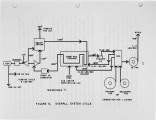| OCR Text |
Show 16 More open convective section designs would be beneficial, but heat transfer efficiency drops as gas velocity drops. Lower cost alloys would allow more maintenance friendly designs. Though not directly related to the combustion process, one of the most exciting developments in small power systems is the "shaft speed" alternating current generator. By computer controlled solid state electronics, in phase ac power can be generated without the generator being physically in phase with the system. This means that with high speed turbines such as the Spartan (shaft speed 37057 rpm) the gearbox with its attendant weight and complexity can be eliminated. Accurate speed control is not required and from that sense reduces the impact of control system inputs. These devices have been perfected for generators up to 300 kW and are now undergoing commercial evaluation. It is anticipated that future ENERGEO products will incorporate this technology. Because of the thermal energy contained in the waste heat streams - flue gas and turbine exhaust recuperator exit - several auxiliary devices can be coupled to the system. These include possible fuel drying, water distillation or purification, water heating; and steam for uses such as food processing, chillers, and air conditioning systems. Since these devices would be running off a waste heat stream, high efficiency is not required for the initial introduction of these improvements. SUMMARY The externally fired gas turbine cycle presents many challenges to the designers of such systems. The ability to bum fuel of any quality, independent of the gas turbine process air requirements is too tempting an area to ignore. Virtually any fuel is a candidate - wood, agricultural waste, coals, trash, etc. Good understanding of materials, and imagination in designing the heat exchange elements are essential. This is an area which is totally open to innovation. |




















